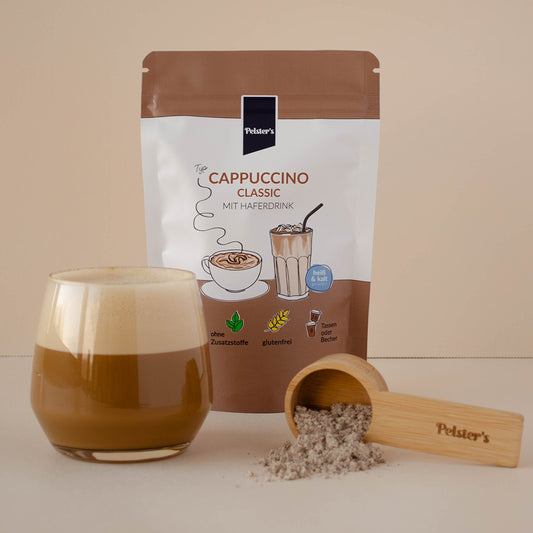Oats are one of the most versatile and health-promoting grains, playing an important role in both human nutrition and animal feed. Since the mid-1980s, oats have been valued as a health food, especially for their positive effects on heart health. In this article, we take a look at the history, cultivation, processing and nutritional benefits of oats. (1)
History and meaning
Oats belong to the Poaceae family and are one of the most important cultivated oats (Avena sativa L.). Originally, oats were mainly grown as animal feed, but since the 1980s they have become increasingly important as a food. The breakthrough came with the discovery that oats can help prevent heart disease. This property has enormously increased interest in oats for human nutrition. (1)

Use of oats
Due to their lack of gluten, oats are not suitable for baking bread. Nevertheless, they are a staple in modern cuisine and are often used in porridge, breakfast cereals, cereals and plant-based milk alternatives such as oat drinks. For people with celiac disease, oats offer a valuable alternative to other grains as they are naturally gluten-free. However, the oat grains must be peeled before use. The shells are also used in various areas.
Cultivation of oats
Oats are grown worldwide, especially in the temperate climates of Central and Northern Europe, as well as in the USA and Canada. These regions offer ideal conditions for growing oats as they have moderate temperatures and high rainfall. Compared to other cereals, such as wheat, oats are more resilient to wet weather and acidic soils. Oats are also resistant to many leaf diseases and require fewer pesticides and fertilizers, making them an environmentally friendly crop. (2)
Another advantage of oat cultivation is its role as a "health crop". This means that oats have the potential to break disease cycles that often occur in intensive wheat cultivation. Due to their deep and dense root system, oats can absorb nutrients efficiently and improve soil structure. Due to these positive properties, it is recommended that oats be more integrated into arable farming strategies. (3)
Processing of oats
The oat grain is naturally indigestible and must be milled before it can be used. This allows the oats' nutritional benefits to be released. The processing process begins with cleaning the oats, which removes unwanted foreign matter. After that, the grains are sorted by size and dehulled to expose the digestible groats. This is followed by oven drying, which inactivates enzymes that could cause rancidity and undesirable flavor changes. These steps extend the shelf life of the oats and increase food safety.
The processed oat groats are transformed into various food products, including oatmeal and oat flour. These products are essential in many kitchens and provide a healthy and versatile source of nutrition. (4)
Nutritional values and health benefits
Oats are rich in carbohydrates, proteins, unsaturated fatty acids and fiber. A large proportion of the carbohydrates are in the form of slowly digestible starch molecules that stabilize blood sugar levels and prevent cravings. (5) The fiber in oats is particularly valuable because it contains both soluble and insoluble components. Soluble fiber, such as β-glucan, slows down gastric emptying and glucose absorption, which leads to more stable blood sugar levels and a reduction in cholesterol and blood pressure. (1,5)
Insoluble fiber promotes gut health by supporting intestinal function. (1) Oats offer numerous health benefits. Phytochemicals in oats, including phenolic compounds, have antioxidant and anti-inflammatory properties and may reduce symptoms of diabetes and obesity.
Oats are also a good source of micronutrients such as vitamin E, folic acid, zinc and iron. As a whole grain, oats offer anti-cancer properties and help with gastrointestinal problems. The processing of oat drinks has only a minor impact on the vitamin and mineral content. Ultra-high temperature treatment is necessary to ensure microbiological stability. However, longer storage times can reduce the content of linoleic acid, vitamin A, vitamin D and vitamin B12. (5) Therefore, storage in a dry place protected from light is particularly important in order to reduce the degradation of important nutrients. We pay particular attention to this with our products. In addition, the nutrients do not evaporate in water, as it is always added fresh to the oat drinks , so that the nutrients are preserved for a long time.
Conclusion
Oats are a remarkable grain with a wide range of health benefits and uses. From promoting heart health to supporting gut function, oats offer a valuable addition to any diet. Their environmental friendliness and role as a health crop make them an important crop for the future. Whether in the form of oatmeal, oat drinks or other products, oats remain an essential food for a healthy lifestyle.
Photos: pixabay, pelster´s
Sources:
- (1) Butt, MS, Tahir-Nadeem, M., Khan, MKI, Shabir, R., & Butt, MS (2008). Oat: unique among the cereals. European journal of nutrition, 47, 68-79.
- (2) Stewart, D., McDougall, G. (2014). Oat agriculture, cultivation and breeding targets: implications for human nutrition and health. British Journal of Nutrition, 112(S2), S50-S57.
- (3) (2019). WWF study Diversity in the fields (summary). Online at: https://www.wwf.de/fileadmin/fm-wwf/Publikationen-PDF/Landwirtschaft/wwf-studie-vielfalt-auf -den-acker-summed-up.pdf (last accessed: 06.02.2024).
- (4) Decker, E.A., Rose, DJ, & Stewart, D. (2014). Processing of oats and the impact of processing operations on nutrition and health benefits. British Journal of Nutrition, 112(S2), S58-S64.
- (5) Rasane, P., Jha, A., Sabikhi, L., Kumar, A., & Unnikrishnan, V.S. (2015). Nutritional advantages of oats and opportunities for its processing as value added foods-a review. Journal of food science and technology, 52, 662-675.




























Muchas gracias. ?Como puedo iniciar sesion?
Muchas gracias. ?Como puedo iniciar sesion?